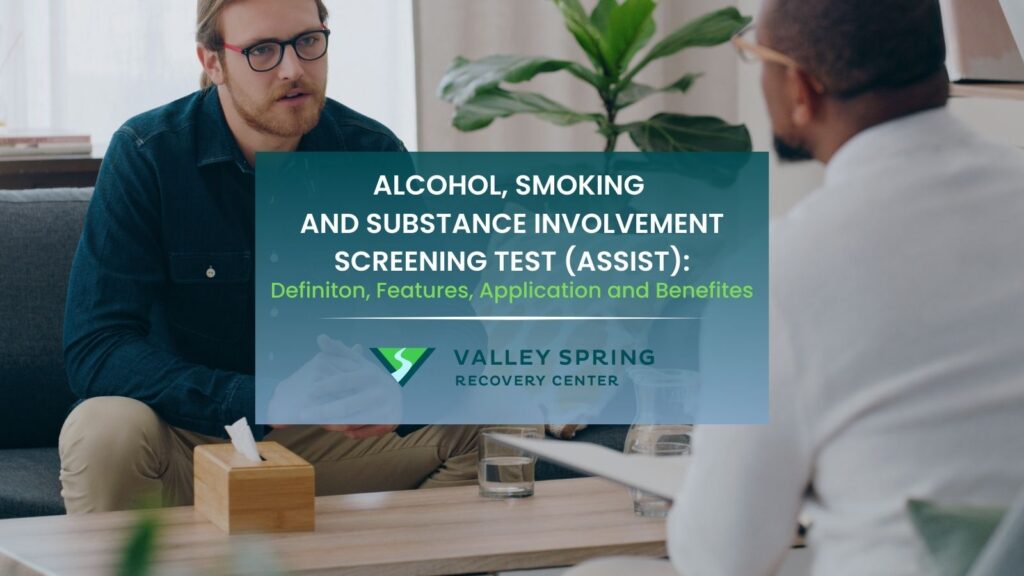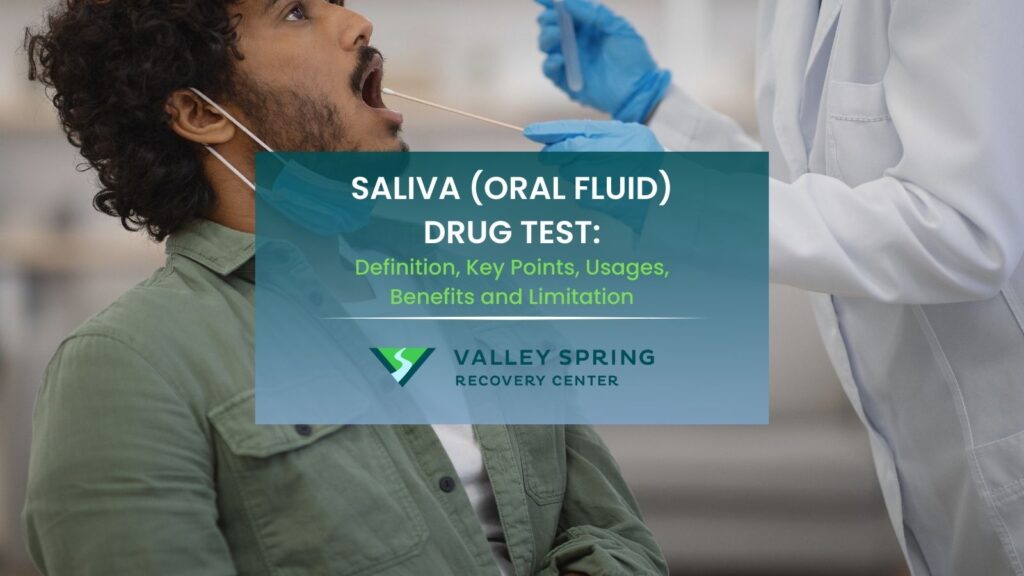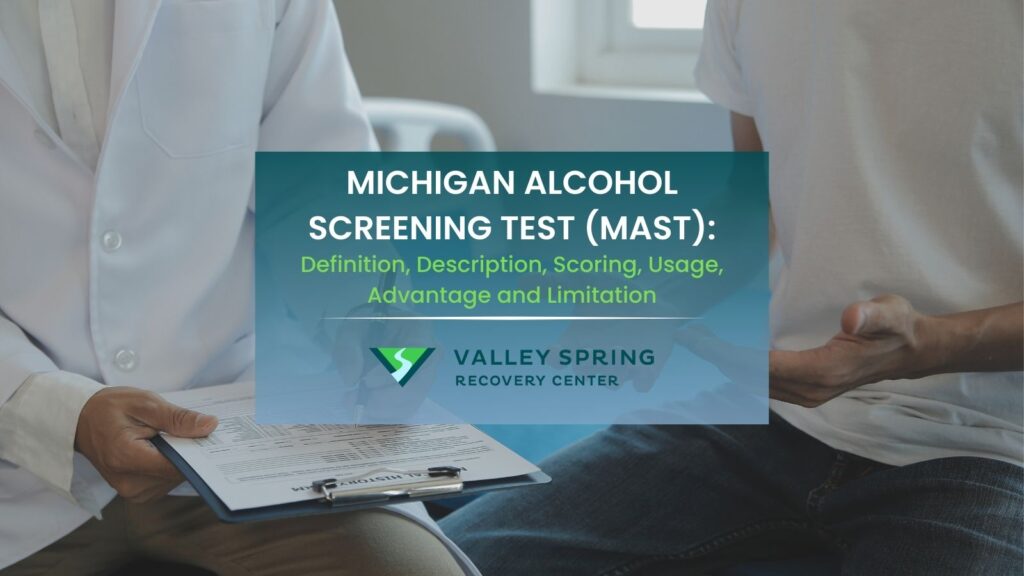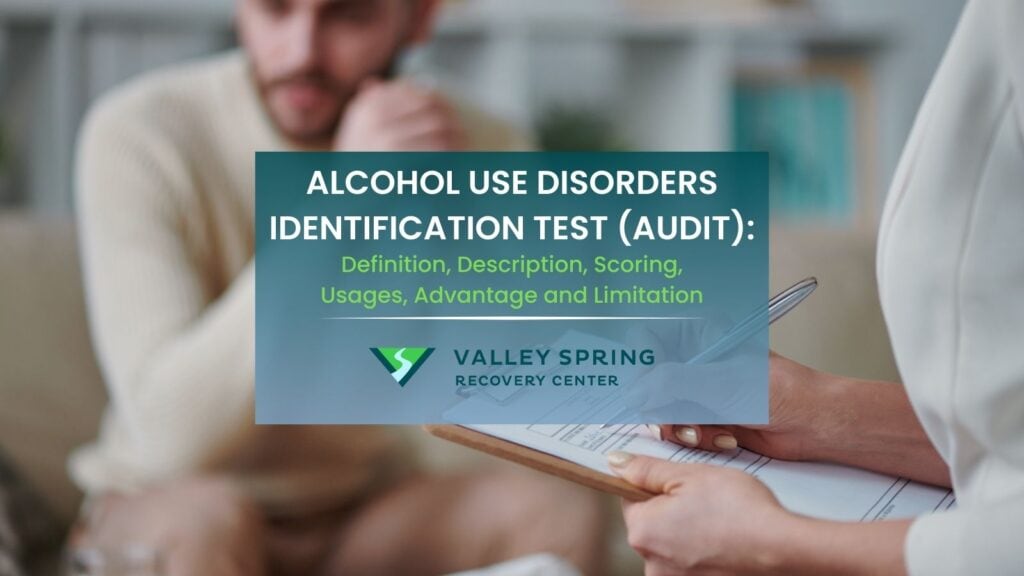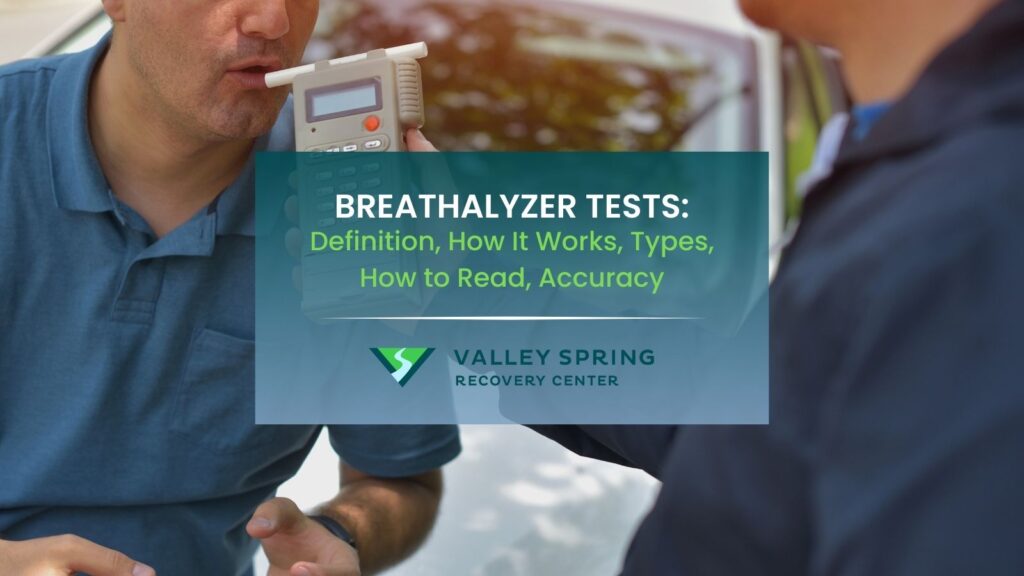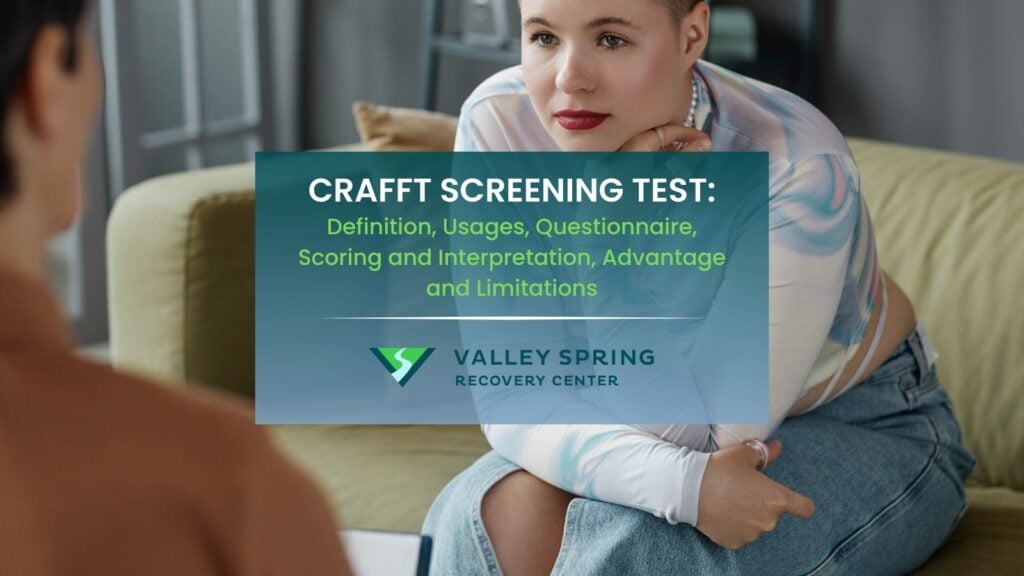The ASSIST tool is a questionnaire designed to assess an individual’s substance use patterns and related problems. It was developed by the World Health Organization (WHO) to help healthcare professionals identify substance use risks and provide appropriate interventions.
The ASSIST tool is applied by healthcare professionals who administer a standardized questionnaire to individuals, assessing their substance use patterns and associated problems to identify potential risks and guide appropriate interventions. It can also be self-administered.
The benefits of the ASSIST tool include comprehensive substance use assessment, standardized screening, early identification of individuals at risk, risk stratification, referral guidance, brief intervention support, and adaptability to diverse populations and settings.
The limitations of the ASSIST tool include potential self-report bias, limited diagnostic capability, cultural and contextual considerations, lack of specificity for certain substances, limited focus on specific populations, lack of longitudinal assessment, and the need for professional training.
What is the Alcohol, Smoking, and Substance Involvement Screening Test (ASSIST)?
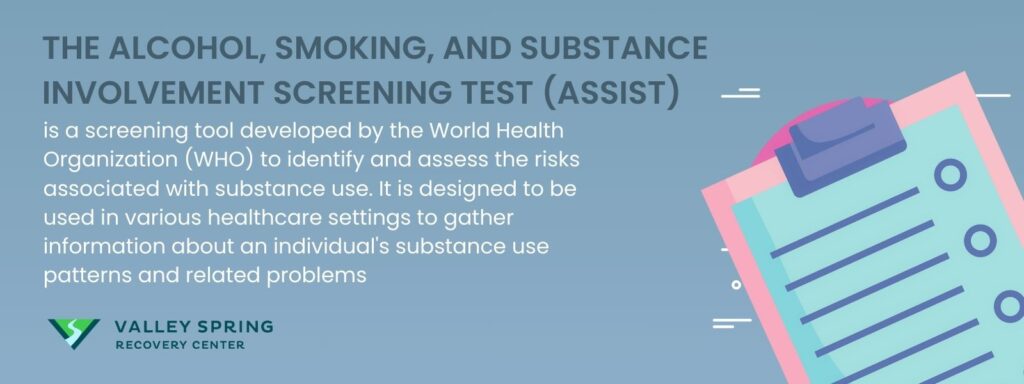
The Alcohol, Smoking, and Substance Involvement Screening Test (ASSIST) is a screening tool developed by the World Health Organization (WHO) to identify and assess the risks associated with substance use. It is designed to be used in various healthcare settings to gather information about an individual’s substance use patterns and related problems.
The ASSIST questionnaire consists of 8 core questions that assess the use of different substances, including alcohol, tobacco, cannabis, cocaine, amphetamines, inhalants, sedatives, hallucinogens, opioids, and other drugs. The questions cover frequency of use, associated problems, and dependence symptoms.
Based on the responses, individuals are categorized into different risk levels: low, moderate, or high. The ASSIST also provides recommendations for intervention and treatment based on the identified risk level. It aims to facilitate early intervention and appropriate referrals to further assessment or treatment services.
The ASSIST is a valuable tool for healthcare professionals and researchers to identify substance use problems, provide brief interventions, and guide treatment planning. A study by the WHO ASSIST Working Group to assess the reliability of the test found that the test-retest reliability coefficients (kappas) ranged from 0.58 to 0.90, indicating good to excellent reliability across various substance classes.
What 8 Questions are Featured in the ASSIST Test?
The Alcohol, Smoking and Substance Involvement Screening Test (ASSIST) consists of eight questions, includingt:
- Have you used tobacco products (such as cigarettes, cigars, or chewing tobacco) in the past three months?
- Have you had a drink containing alcohol in the past three months?
- Have you used cannabis (marijuana, hashish) in the past three months?
- Have you used cocaine (including crack) in the past three months?
- Have you used amphetamine-type stimulants (such as speed, ice, or ecstasy) in the past three months?
- Have you used inhalants (such as glue, aerosols, or solvents) in the past three months?
- Have you used sedatives or sleeping pills (such as Valium, Serepax, or Rohypnol) in the past three months?
- Have you used hallucinogens (such as LSD or magic mushrooms) in the past three months?
These questions cover a range of substances commonly used and help assess the level of risk associated with each substance. The scores obtained from these questions are used to determine the level of intervention recommended, such as a brief intervention or referral to specialist treatment.
How is the ASSIST tool Used and Scored?
The WHO provides a manual for the use of ASSIST in primary care settings. This manual describes the rationale for screening and brief intervention, problems related to substance use, the development and validation of the ASSIST, and how to use the ASSIST (administration, scoring, and interpretation of scores):
1. Administration
The ASSIST questionnaire consists of three sections. Section 1 gathers information about the individual’s demographic details and substance use history. Section 2 assesses the individual’s use of various substances. Section 3 covers the individual’s experiences with substance-related problems and dependence symptoms.
2. Scoring
Each substance category in Section 2 is scored separately. The scores are calculated based on the frequency of use and associated problems. The individual’s responses in Section 3 are also scored to assess the level of dependence symptoms.
3. Risk categorization
After scoring, the individual is categorized into one of three risk levels: low, moderate, or high. The risk level is determined by comparing the scores obtained to predetermined cutoff values provided in the ASSIST manual.
4. Recommendations
Based on the risk level identified, the ASSIST provides recommendations for appropriate interventions or referrals. These recommendations are designed to guide healthcare professionals in providing tailored interventions and treatment options.
If a substance use disorder is suspected, further assessment and evaluation by a qualified healthcare professional are necessary.
What are the Benefits of the ASSIST Tool?
There are 7 key advantages of using the ASSIST, including comprehensive assessment, standardized screening, early identification, risk stratification, referral guidance, brief intervention support, and adaptability:
1. Comprehensive assessment
The ASSIST covers a wide range of substances, including alcohol, tobacco, and various illicit drugs. This comprehensive approach allows for a thorough assessment of an individual’s substance use patterns and related problems.
Research by Humeniuk, et al, titled Validation of the alcohol, smoking and substance involvement screening test (ASSIST) concluded that the ASSIST is a reliable and valid tool for screening and comprehensively assessing substance use issues across different substances and severities
2. Standardized screening
The ASSIST provides a standardized framework for screening and assessing substance use. It offers a consistent set of questions and scoring guidelines, ensuring that healthcare professionals obtain reliable and comparable data across different individuals and settings.
3. Early identification
The ASSIST helps in the early identification of individuals at risk for substance use problems. By detecting problematic substance use patterns, it enables healthcare professionals to intervene at an early stage, potentially preventing the progression to more severe substance use disorders.
4. Risk stratification
The tool categorizes individuals into low, moderate, or high-risk levels based on their responses and scores. This risk stratification assists healthcare professionals in tailoring interventions and treatment recommendations based on the identified level of risk.
5. Referral guidance
The ASSIST provides guidance on appropriate referrals based on the identified risk level. It helps healthcare professionals make informed decisions regarding the need for further assessment, specialized treatment, or support services for individuals who require additional help.
6. Brief intervention support
The ASSIST includes a brief intervention component, which offers suggestions for healthcare professionals to deliver brief interventions to individuals identified as having moderate-risk substance use. These brief interventions aim to motivate behavioral change and reduce potential harms associated with substance use.
7. Flexibility and adaptability
The ASSIST can be adapted to various cultural and language contexts, making it suitable for use in diverse populations. It can be modified to accommodate local substance use patterns and specific populations, ensuring its applicability in different settings.
Overall, the ASSIST tool contributes to improved screening, assessment, and intervention processes in substance use healthcare.
What are the Limitations of The ASSIST Tool?
The downsides of the ASSIST test include the following:
- Self-report bias: Reliance on individual responses may lead to underreporting or inaccurate information about substance use.
- Limited diagnostic capability: The ASSIST is a screening tool and does not provide a definitive diagnosis of substance use disorders.
- Cultural and contextual considerations: The tool may not fully capture cultural variations and specific contextual factors influencing substance use.
- Lack of specificity: While comprehensive, the ASSIST may not capture specific details about certain substances or emerging trends.
- Limited focus on specific populations: Its applicability to certain groups, such as adolescents or older adults, may vary.
- Lack of longitudinal assessment: The ASSIST assesses substance use at a specific time and does not track changes over time.
- Professional training required: Accurate administration and interpretation of the ASSIST require trained healthcare professionals familiar with its guidelines.
What is the ASSIST-FC Screening Tool?
The ASSIST-FC (Alcohol, Smoking and Substance Involvement Screening Test – Frequency and Concern) is a screening tool developed by the World Health Organization (WHO) to identify individuals with hazardous and harmful substance use. It is a shorter version of the full ASSIST instrument, designed to provide a brief and efficient screening process.
The ASSIST-FC consists of two questions:
- Frequency (F) of current substance use.
- Current or past concerns (C) expressed by others regarding substance use.
The ASSIST-FC was proposed through a study that aimed to identify a subset of questions from the full ASSIST instrument that had comparable psychometric properties for the classification of low-, moderate-, and high-risk substance use. The study proposed a two-item version called ASSIST-FC, which demonstrated no substantial loss in reliability, validity, and predictive ability compared to the full-length ASSIST.
Since then, several studies have been conducted to verify the reliability of this tool, like the Shmulewitz study of 2023, titled Test characteristics of shorter versions of the ASSIST for brief screening for problematic substance use in a population sample from Israel. The research found that the ASSIST-FC scores showed high ability to identify problematic use, with minimal differences by gender or age. The study also discussed the binary ASSIST-FC thresholds for most substances and alcohol, showing high specificity and positive predictive value, acceptable sensitivity, and good agreement
What substances does the ASSIST assess?
The ASSIST assesses the use of various substances, including alcohol, tobacco, cannabis, cocaine, amphetamines, inhalants, sedatives, hallucinogens, opioids, and other drugs. It covers a wide range of substances commonly used worldwide, allowing healthcare professionals to gather comprehensive information about an individual’s substance use patterns and related problems.
The ASSIST has also shown promise for other forms of addiction not related to substance use. According to a study by Qeadan, et al (2024), titled Using the ASSIST to Predict Gambling Disorder Among U.S. College Students, lower thresholds of substance risk related to prescription opioids, cocaine, and hallucinogens (all with SSIS cutoffs of 4) were found to predict gambling disorder compared to sedatives (SSIS cutoff of 19).
How does the ASSIST categorize individuals into different risk levels?
The ASSIST categorizes individuals into different risk levels (low, moderate, or high) based on their scores. Each substance category is scored separately, taking into account the frequency of use and associated problems. The scores are compared to predetermined cutoff values provided in the ASSIST manual. The risk level is then determined based on the individual’s scores and their corresponding severity in relation to the cutoff values.
How does the Alcohol, Smoking and Substance Involvement Screening Test (ASSIST) compare to the CAGE Questionnaire in terms of screening effectiveness?
The Alcohol, Smoking and Substance Involvement Screening Test (ASSIST) and the CAGE Questionnaire are both used to screen for substance use disorders, but they differ significantly in their scope and effectiveness. The ASSIST is a comprehensive tool developed by the World Health Organization (WHO) that screens for a wide range of substances, including alcohol, tobacco, and various drugs, assessing the frequency and impact of their use. In contrast, the CAGE Questionnaire is a shorter tool specifically designed to identify potential alcohol problems through four key questions. While the CAGE is quick and easy to administer, the ASSIST provides a broader assessment, making it more effective for identifying multiple substance use issues and informing targeted interventions.
How can the ASSIST tool be integrated with saliva drug testing to enhance substance use assessments?
Integrating the ASSIST tool with saliva drug testing can enhance substance use assessments by combining comprehensive self-reported data with objective biological evidence. The ASSIST tool helps identify individuals’ patterns of substance use and associated risks, while saliva drug testing provides immediate, accurate results on recent drug use. This integration allows healthcare providers to validate self-reported information from the ASSIST with biological data, improving the accuracy of the assessment. Using both methods together can also help in monitoring treatment progress and adherence, ensuring a more holistic and reliable approach to managing substance use disorders.
Can the ASSIST be used in non-clinical settings, such as community outreach programs?
Yes, the ASSIST can be used in non-clinical settings, including community outreach programs. Its flexibility allows for administration outside of traditional healthcare settings. Community outreach programs can utilize the ASSIST as a screening tool to identify individuals at risk for substance use problems and provide appropriate interventions or referrals based on the results. This can help reach a broader population and facilitate early intervention and support for individuals in need.
Can the ASSIST be self-administered or does it require a healthcare professional?
The ASSIST can be administered in both self-report and healthcare professional-led formats. It can be self-administered by individuals, where they complete the questionnaire independently and provide their own responses. Alternatively, a healthcare professional can conduct an interview-style assessment using the ASSIST, asking the questions and recording the individual’s responses. Both approaches are valid and can be used based on the specific context and resources available.
Dr. Michael Olla
All author postsShare This Post

